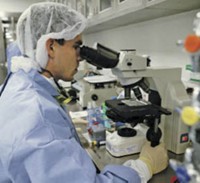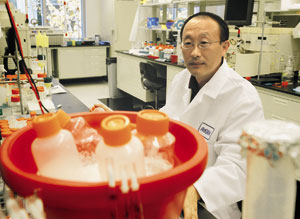Advertisement
Grab your lab coat. Let's get started
Welcome!
Welcome!
Create an account below to get 6 C&EN articles per month, receive newsletters and more - all free.
It seems this is your first time logging in online. Please enter the following information to continue.
As an ACS member you automatically get access to this site. All we need is few more details to create your reading experience.
Not you? Sign in with a different account.
Not you? Sign in with a different account.
ERROR 1
ERROR 1
ERROR 2
ERROR 2
ERROR 2
ERROR 2
ERROR 2
Password and Confirm password must match.
If you have an ACS member number, please enter it here so we can link this account to your membership. (optional)
ERROR 2
ACS values your privacy. By submitting your information, you are gaining access to C&EN and subscribing to our weekly newsletter. We use the information you provide to make your reading experience better, and we will never sell your data to third party members.
Business
A Steady Start For Biopharma Companies
Larger biotech firms are starting to feel the same portfolio challenges as big pharma companies
by Lisa M. Jarvis
May 22, 2006
| A version of this story appeared in
Volume 84, Issue 21
Highlighting the challengeof sustaining high sales growth as a product portfolio ages, first-quarter financial results show that some major biotech companies are starting to experience growing pains. However, the quarter also brought the first taste of success to a handful of smaller biotech firms that recently launched products.
Taken as a whole, first-quarter 2006 earnings of the 20 biotech companies tracked by C&EN were up 48.5% to $2.9 billion, while revenues grew 24.4% to $11.8 billion. A combined profit margin of 24.6% was a substantial improvement over the margin of 20.6% for the first quarter of 2005.
Stock analysts were disappointed with the showing from the biggest of the biotechs, Amgen. Earnings increased 19.2% to $1.1 billion based on a 13.6% rise in revenues to $3.2 billion.
Despite double-digit revenue and profit growth, sales on several key products were not as robust as expected. Furthermore, Amgen revealed a one-year delay in the filing of a New Drug Application for the osteoporosis treatment denosumab, which many industry observers have touted as the company's next billion-dollar product.
Amgen's Enbrel has come under pressure from competing treatments, and its market share in both the rheumatoid arthritis and psoriasis markets slipped slightly in the first quarter, according to the investment bank Friedman Billings Ramsey. Sales of Enbrel totaled $658 million, an 11% increase over the prior year but well below analysts' average estimate of $716 million.
Sales of Amgen's anemia drug Epogen stabilized in the quarter after losing market share in certain segments in 2005 to the company's other anemia product, Aranesp. Epogen brought in $604 million in U.S. sales, a 4% increase. Aranesp, on the other hand, enjoyed a 24% rise in sales to $893 million. However, sales of both drugs were down compared with those in the fourth quarter of 2005.
Biogen Idec's results reflect the company's heavy reliance on drugs that, by biotech industry standards, are ancient. Though earnings improved by 78.5% to $189 million, revenues were up just 4.0% to $611 million.
Biogen Idec's two main sources of income are Avonex, the multiple sclerosis drug launched a decade ago, and revenues from sales of Genentech's cancer treatment Rituxan, which received its first approval in 1997. Revenues from Rituxan were up 14% to $183 million, while sales of Avonex increased 5% to $393 million.
On the positive side, a Food & Drug Administration committee recommended the reintroduction of the multiple sclerosis drug Tysabri, which could put Biogen Idec back on a steeper growth path. FDA will make a final decision on Tysabri-taken off the market in early 2005 after several patients died-by the end of June.
Another big biotech, Genentech, started the year off right on track, with earnings jumping 57.4% to $491 million, based on a 35.8% rise in revenues to $2.0 billion. The company's portfolio of cancer drugs fueled growth; three of four products saw revenues that were almost double those of the first quarter of 2005.
The colon cancer drug Avastin continues to be an enormous success story for Genentech. The drug raked in $398 million in U.S. revenues, versus $203 million in the 2005 quarter.
The breast cancer drug Herceptin continued to build on the momentum that began last year following the release of new studies showing the drug can help decrease the risk of tumor recurrence in early-stage breast cancer patients. The drug brought in $290 million in the quarter, a whopping 123% increase over the first quarter of 2005, and a 16% improvement compared with the fourth quarter of last year. Meanwhile, U.S. sales of the lung cancer drug Tarceva were up 94% to $93 million.
Sales of the non-Hodgkin's lymphoma drug Rituxan were Genentech's disappointment. The drug brought in $477 million, an 8% increase over the first quarter of 2005 but nearly $40 million less than analysts' forecasts. Furthermore, the company saw the drug's sales slip 2% compared with the fourth quarter of 2005, despite FDA permission to use Rituxan as a treatment for rheumatoid arthritis.
Gilead Sciences also put its good foot forward in the first quarter, balancing out declining sales on older HIV products with a strong showing from newer HIV drugs. Earnings were up 82.2% to $286 million, while sales surged 61.0% to $693 million.
Gilead's Truvada, launched in the third quarter of 2004, saw sales skyrocket to $249 million from $92 million in the first quarter of 2005. The improvement offset a 3% decrease in sales of Viread, which brought in $192 million, and a 20% drop in sales of Emtriva to $10 million.
While bigger biopharmaceutical companies are grappling with the same portfolio challenges that big pharma encounters, several small and medium-sized biotech companies are on the road to profitability as their first products establish themselves in the market.
Though revenues at Millennium Pharmaceuticals were down slightly in the first quarter due to a reconfigured relationship with Schering-Plough over the cardiovascular drug Integrilin, the company turned a profit for the first time. U.S. sales of the multiple myeloma treatment Velcade were up 19% to $53 million, driven by expanded use of the drug.
ImClone Systems also had a strong quarter, with revenues soaring to $245 million, versus $86 million in the first quarter of 2005. Bristol-Myers Squibb, ImClone's partner in the U.S., reported sales of $138 million for the colon cancer drug Erbitux, a 58% increase. Sales are expected to continue to ramp up as use of the drug expands this year into head and neck cancer-an $800 million market where Erbitux has no competition, says Jim Reddoch, Friedman Billings Ramsey's managing director.
Amylin Pharmaceuticals' results were fueled by the launch of its first products, the diabetes drugs Byetta and Symlin. First-quarter revenues jumped to $82.3 million, compared with just $4.3 million in same period in 2005. Byetta, launched in the second quarter of 2005, brought in $68 million in the first quarter of 2006.
Amylin told investors that demand may exceed supply this year if the drug continues to grow at that clip. The company is now working with manufacturers to quadruple capacity for the drug by the end of the year, says Andrew Forman, WR Hambrecht & Co. analyst, in a note to investors. Despite the constraint, Forman expects sales of the drug to exceed $400 million in 2006.
Table: Biopharmaceutical Companies
Smaller biotech companies are finally moving toward profitability.
Table is available as an image file.




Join the conversation
Contact the reporter
Submit a Letter to the Editor for publication
Engage with us on Twitter